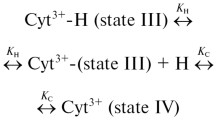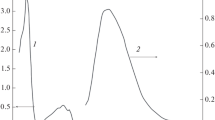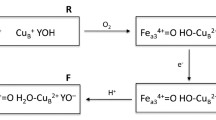Abstract
The pH dependence of the dynamic quenching of the luminescence from Tb(III) and Eu(III) tris(pyridine-2,6-dicarboxylate≡DPA) chelates by the title proteins is studied. For Tb(DPA)3 3– also the quenching by the Lys 14→Glu and Lys99→Glu mutants of cytochrome c-550 (cytc-550) is investigated. The rate constants for quenching of the electronically excited Λ and Δ enantiomers of the luminophore by equine cytochrome c show a sharp decrease upon increasing the pH from 7 to 10, which can be described phenomenologically by deprotonation of a single acidic group with pK a of 9.2±0.1 for Eu and 9.4±0.1 for Tb. These values are similar to that found for the alkaline transition of the protein. The alkaline conformer(s) of the protein at pH>10 is found to be a very inefficient quencher of the lanthanide luminescence. For Tb, but not for Eu, a significant lowering of the degree of enantioselectivity (E q) in the quenching is found along with a reduction of the quenching rates. For cytc-550, the decrease of the quenching rate constants with increasing pH is described by pK a=9.8±0.1 and for the two mutants the same value is obtained. For the cytc-550 proteins the change of the quenching rates does not correlate with the alkaline transition, for which a pK a of 11.2 has been reported by other workers. For all proteins, the reduction of the quenching rates at high pH is ascribed to a reduction of the binding affinity of the excited lanthanide complex to the surface area of the protein near the exposed heme edge, caused by deprotonation of (presumably) several lysine residues.
Similar content being viewed by others
Author information
Authors and Affiliations
Additional information
Received: 3 April 1998 / Accepted: 15 June 1998
Rights and permissions
About this article
Cite this article
Meskers, S., Ubbink, M., Canters, G. et al. pH dependence of the enantioselective excited-state quenching of Λ,Δ-Tb(III) and Λ,Δ-Eu(III)tris(pyridine-2,6-dicarboxylate) chelates by ferricytochrome c from horse heart and ferricytochrome c-550 from Paracoccus versutus . JBIC 3, 463–469 (1998). https://doi.org/10.1007/s007750050256
Issue Date:
DOI: https://doi.org/10.1007/s007750050256




